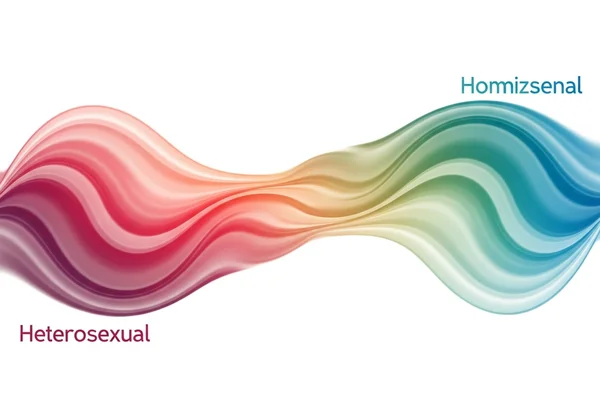Kinsey Scale Test: How It Works & What Questions to Expect
Exploring yourself is a unique journey, sometimes exciting, sometimes a bit daunting. If you've found yourself exploring your identity, you may have come across the kinsey scale test. But what kind of questions does it ask, and how does it translate your feelings into a score? You're in the right place for answers. This guide will help you understand the Kinsey Scale, offering a clear look into its mechanics and what to expect, empowering you on your path to understanding yourself.
The process of exploring sexual orientation is deeply personal. Having a tool that provides a framework for your thoughts can be incredibly validating. We believe in providing a safe, private, and insightful space for this exploration. As you read, you'll gain the confidence to start your exploration and see how this tool can serve you.
Understanding the Kinsey Scale: Beyond Binary Labels
Before diving into the questions, it's essential to grasp the core concept behind the Kinsey Scale. Developed by Alfred Kinsey and his colleagues in the 1940s, this tool revolutionized the way we talk about human sexuality. It challenged the rigid, binary view of sexual orientation and introduced the idea of a fluid spectrum.
This approach acknowledges that a person's sexual feelings and behaviors can exist somewhere between exclusively heterosexual and exclusively homosexual. Understanding this foundation is the first step in using the Kinsey Scale not as a rigid label, but as a mirror for self-reflection.

What is the Kinsey Scale and Why Explore Your Orientation?
At its heart, the Kinsey Scale is a tool designed to plot your position on a continuum of sexual orientation. It's not a medical diagnosis or a definitive label. Instead, think of it as a snapshot of your feelings and experiences at a particular point in time. People explore their orientation for many reasons: curiosity, self-acceptance, or to better understand their relationships and attractions.
The journey of self-understanding is unique to each individual. Using the Kinsey Scale can be a powerful act of self-care, providing language and context for feelings you may have struggled to define. It offers a structured way to reflect on your attractions and experiences in a non-judgmental framework.
The Kinsey Continuum: From Exclusively Heterosexual to Exclusively Homosexual
The most famous aspect of the Kinsey Scale is its seven-point rating system, from 0 to 6. This spectrum provides a more nuanced view than simple categories. Here’s a basic breakdown of the kinsey scale meaning:
- 0: Exclusively heterosexual
- 1: Predominantly heterosexual, only incidentally homosexual
- 2: Predominantly heterosexual, but more than incidentally homosexual
- 3: Equally heterosexual and homosexual
- 4: Predominantly homosexual, but more than incidentally heterosexual
- 5: Predominantly homosexual, only incidentally heterosexual
- 6: Exclusively homosexual
There is also an "X" category for individuals who report no socio-sexual contacts or reactions. This continuum validates the wide diversity of human experience, showing that sexuality is not an either/or proposition.
Decoding the Kinsey Scale Questions: What to Expect
Knowing what the test involves can ease any anxiety and help you approach it with an open mind. A kinsey scale online test doesn't ask trick questions. It simply prompts you to reflect on your personal experiences and feelings across different areas of your life. We aim to get a complete picture of your orientation.
The questions are designed to be straightforward and introspective. Our interactive quiz guides you through this process in a supportive way, ensuring you feel comfortable as you explore. Ready to see what it's like? You can take the free test on our homepage.
The Three Dimensions: Attraction, Behavior, and Fantasy
The questions in the Kinsey Scale test typically revolve around three core dimensions of your experience. This approach, looking at multiple facets of your life, helps create a more accurate reflection of your orientation.
- Attraction: This dimension explores who you are romantically or erotically drawn to. It focuses on your internal feelings, independent of any actions you've taken.
- Behavior: This section asks about your actual sexual experiences with people of different genders. It's a look at your history and actions.
- Fantasy: This delves into your sexual fantasies and daydreams. Fantasies can be a powerful indicator of desire, separate from both attraction and behavior.
By examining these three areas, the scale creates a more complete picture. It acknowledges that what we feel, what we do, and what we imagine can sometimes differ, and each part is a valid piece of our identity.

How Your Responses Contribute to Your Kinsey Score
Your answers to the questions across these three dimensions are not judged as right or wrong. They are simply data points. The methodology behind the kinsey scale score involves weighting your responses to determine where you fall on the 0-6 continuum. For instance, consistent patterns of attraction, behavior, and fantasy towards one gender will move your score toward one end of the spectrum.
Our platform processes your anonymous responses to generate your score instantly. You can then choose to receive an optional AI-powered analysis for a deeper, more personalized understanding of what your results mean for you. This helps translate the number into meaningful insights for your journey.
Ensuring Privacy and Anonymity During Your Test
We understand that exploring your sexuality is an incredibly private matter. That's why your trust is our top priority. When you take the Kinsey Scale quiz on our platform, your experience is completely anonymous and secure. We do not ask for or store any personally identifiable information like your name or email address.
Your responses are used solely to calculate your score and generate your report. You can explore your identity with the peace of mind that comes from knowing your personal journey remains just that—personal.

The Methodology Behind Your Kinsey Test Result
Understanding the kinsey scale methodology helps reinforce that this is a tool for personal insight, not a rigid scientific measurement. It was pioneering for its time and remains a valuable starting point for conversation and self-reflection, even as our modern understanding of sexuality has expanded.
The scale's strength lies in its simplicity and its foundational idea that sexuality is a spectrum. It provides a concrete framework that many find helpful as they navigate their feelings.
From Personal Experience to a Numerical Representation
The process of converting your rich, complex personal experiences into a single number is inherently a simplification. Your life and feelings are more than a score. The number is best used as a guidepost or a conversation starter for further self-reflection.
Think of the score as a summary of the patterns in your responses. It helps to locate your general position within the broader landscape of human sexuality as defined by Kinsey's research. The real value comes from the thoughts and feelings the process brings up for you.
Is the Kinsey Scale a Definitive Label or a Tool for Exploration?
This is a crucial distinction. The Kinsey Scale is not meant to give you a permanent, unchangeable label. It is a tool for exploration. Your feelings, attractions, and behaviors can be fluid and may change over time. Your score today might be different from a score five years from now, and that's perfectly normal.
Embrace the scale as a way to check in with yourself. Use it to foster curiosity about who you are right now. The results from our online tool are there to empower you with insight, not to put you in a box.
Ready to Explore? Your Kinsey Scale Journey Awaits
We've explored the Kinsey Scale together, looking at how it works, what questions to expect, and the private, secure process behind it. Now, you have a clear picture of this valuable tool and how it can support your journey of self-discovery. It's a structured, non-judgmental way to reflect on your unique experiences.
The next step is yours to take. If you feel ready to gain personal insight and see where you fall on the spectrum, we invite you to begin. Your exploration is a click away. Discover your results on our homepage today.
Frequently Asked Questions About the Kinsey Scale Test
What does a Kinsey Scale score actually mean?
A Kinsey Scale score represents your position on a 0-6 spectrum of sexual orientation, from exclusively heterosexual (0) to exclusively homosexual (6). It is a reflection of your self-reported patterns of attraction, behavior, and fantasy. It's important to view your score not as a strict label but as a tool for self-understanding, providing a snapshot of your feelings at this point in your life.
How long does the Kinsey Scale test typically take?
The test is designed to be quick and user-friendly. Most people complete the questionnaire on our platform in just a few minutes. We encourage you to take your time and answer thoughtfully, as honest self-reflection will provide the most meaningful results.
Is my Kinsey Scale test result completely private and anonymous?
Yes, absolutely. Here on our platform, we guarantee your privacy. The test is fully anonymous, and we do not collect any personal data that could identify you. You can take the test with full confidence that your journey of exploration is secure and confidential. To start your private assessment, you can begin the quiz on our homepage.
Is the Kinsey Scale still considered a valid measure of sexuality today?
While groundbreaking, the Kinsey Scale has its limitations. Modern understandings of sexuality are more expansive, including identities like asexuality and pansexuality that aren't explicitly represented. However, the scale's core concept—that sexuality exists on a continuum—remains highly relevant. It is still a valuable and widely recognized tool for personal exploration and self-reflection, serving as an excellent starting point for many people.